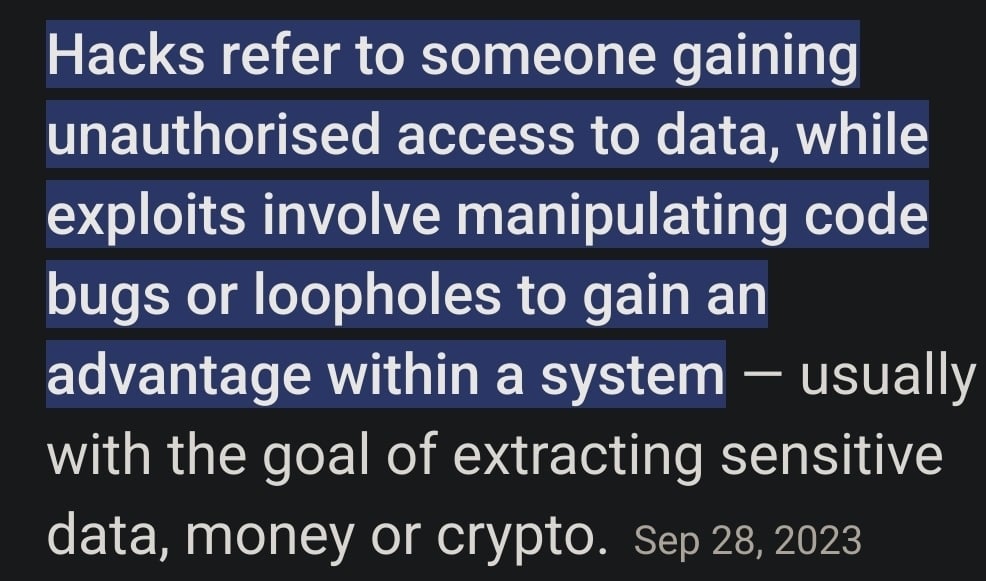‘hacked’. Eh. There was an API endpoint left open that allowed them to basically just spam it with no rate limiting. They used the lack of a rate limit to just pull the data out of the API that it was made to produce.
Yeah. They got data in a way that was not intended. That’s a hack. It’s not always about subverting something by clickity-clacking like in the movies.
i’m in
Well…you son of a birch…now I’m in.
HTP.
Exploit. The system worked as intended, just without a rate limit.
Exploiting is hacking, quit being pedantic.
A missing rate limit is a vulnerability, or a weakness, depending on the definition. You’re playing smart without having an idea of what you’re talking about. Here you go:
https://cwe.mitre.org/data/definitions/799.html
YouTube videos are public, and as such it’s not really hacking. If you were able to download private videos, for example, it would be a vulnerability like “Improper Access Control”. It does not matter in the least whether you use an “exploit” in your definition (which is wrong) or “just increment the video ID”.
The result is a breach of confidentiality, and as such this is to be classified as a “hack”.
Sure. Except you’re wrong and have absolutely idea of what people in this community say about things. Let me be a dick and literally googz this for you and find an embarassing answer because you couldn’t do it yourself.

So your googling proved him right. What’s embarrassing about being right?
They gained unauthorized access. From that guys definition that is a hack, no an exploit
But they are using a loophole to gain sensitive data. They did not gain unauthorised access to the system.
They absolutely gained unauthorized access to the data. Their access was not intended or sanctioned. If it was intended to be public and accessible like it was, this wouldn’t be a story and they wouldn’t have locked down the access.
Hint – by manipulating or exploiting its code
Which I am explaining, they…did…not…do…
They did nothing to the code. They didn’t break the code, they didn’t cause the code to do anything it wasn’t designed to do. They did not exploit any code. They used an API endpoint that was in the open. For its intended purpose, to verify phone numbers. The api verified phone numbers, they verified phone numbers with the api. The only thing they did here…was they did verification on a lot of phone numbers.
They absolutely exploited unintended functionality. If this was intended, they wouldn’t have added rate limiting and locked down the api after. It was clear to say this was certainly not an intended use of the api.
In a video game for example, if there is a an item that caused excessive lagging just by placing the item. Placing a lot of them with the intent to lag the game would be an exploit. They only used items sanctioned by the game, but for unintended reasons and they would likely be banned for exploitation.
You are correct, I replied to the wrong comment
You’re arguing with someone who was agreeing with you 😑
With due respect, you are wrong.
hack
…
- (transitive, slang, computing) To hack into; to gain unauthorized access to (a computer system, e.g., a website, or network) by manipulating code
Hacking means gaining unauthorized access to a computer system by manipulating or exploiting its code.
Exactly what this is. Read the disclosure. What about your response doesn’t fit that?
They did not do it by manipulating code. This wasn’t the result of a code vulnerability. If you leave the door wide open with all your stuff out for the entire neighbourhood to see, you can’t claim you were “broken into”. Similarly, if you don’t secure your endpoints, you can’t claim you were “hacked”.
Lack of rate limiting is a code vulnerability if we are talking about an API endpoint.
Not that discussion makes any sense at all…
Also, “not securing” doesn’t mean much. Security is not a boolean. They probably have some controls, but they still have a gap in the lack of rate limiting.
It is a vulnerability, but exploiting that vulnerability is not generally considered by security experts to be “hacking” in the usual meaning of that term in academic settings. Using an open or exposed API, even one with a sign that says “don’t abuse me”, is generally not considered hacking.
I am a security professional. I would personally not care less to make the distinction, as both are very generic terms that are used very liberally in the industry.
So I don’t see any reason not to call this hacking. This was not an intended feature. It was a gap, which has been used to perform things that the application writer did not intended (not in this form). If fits with the definition of hacking as far as I can tell. In any case, this is not an academic discussion, it is a security advisory or an article that talks about it.

Please provide a link to whatever source claims this.
I hold a computer science degree and this contradicts the definition of “hack” versus “exploit” used in academic settings.
They probably typed it out themself then screenshotted it.
That’s what most exploit-based hacks are. A developer makes a dumb mistake and then someone exploits it to do something they shouldn’t be able to do.
This isn’t about being pedantic but sure, mate.
Companies need to stop using Authy. It’s stupid and pointless when we have a open alternative such as the one used by Google Authenticator or Aegis.
I started using Authy instead of GA because every time I changed the ROM on my phone I would lose all codes, because I would forget every time.
Use aegis, export the keys and then reimport them every time you switch. Trusting your second factor to a cloud is a disaster waiting to happen.
If you want to get fancy setup your own cloud server (nextcloud, Seafile, owncloud etc) and set the backup folder for aegis to the self hosted cloud for easy restore every time you switch ROMs.
GA now backups your codes in your Google account, so this doesn’t happen anymore.
This isn’t about you and your silly follies
I’ve started putting mine into my Bitwarden vault as well as Google auth, mainly because I’m a bit paranoid I’ll wind up locked out of something by trusting a second factor too much
Call my job and tell them this please. I have to use this shite everyday and it sucks.
I expect most usage of authy was based on the open TOTP protocol that Google etc use. The additional benefit was backing up those codes to the authy account, hence the avenue of attack on those accounts.
I agree though, Authy, especially since it was bought out, should be avoided. They deprecated their desktop app which was the only semi useful part of their suite, but I stopped using it years ago.
welp
Red Shazam
Wow, it’s literally the shazam logo, flipped horizontally and red.
Wonder who got paid to make that logo?
deleted by creator
These are not local solutions, but are cross-platform and open source: Bitwarden or Proton Pass.
deleted by creator
Not if you protect the master key with MFA, like a yubikey. Then it’s cryptographically secure for quite a while…at least until quantum computing is affordable enough to be used against your data. Or the database and your yubikey and yourbpassphrase are compromised
Most KeePass clones have it now, i use Keepass2Android plus KeePassX on PC
Bitwarden would be my vote
I’d recommend 2FAS Auth
deleted by creator
Aegis
Does anyone have a suggested alternative for authy? (Please read the whole post before responding)
I’d love to go with an open source solution as I’ve done with my password manager, but that doesn’t seem possible with one of my big requirements:
Scenario: I’ve had my phone robbed abroad and managed to buy a new one and loaded my ESIM back into it—I need to recover access to my 2 factor database via SMS so I’m able to log into my cloud storage and access my password database.
At this point I’d probably be happy to host a service myself on something like AWS and use SNS for this requirement, but I’m not sure anything like that exists ready to go. I’m not particularly interested in rolling something myself for this.
I’d be dubious of jumping from one closed source product to another, but if there’s a particularly good option I’m all ears, I’ve been otherwise happy with authy for about a decade now, but this plus the retirement of the desktop app have me looking elsewhere.
Edit: added emphasis
I use Aegis, which I periodically back up manually off phone.
Sames, aegis ftw
(reposted from another comment mentioning aegis)
Interesting, I’ve seen this one before but it didn’t seem like it would support my deal-breaker scenario—I still can’t seem to see support for that on the readme, could you point me at some docs?
I think the suggestion here is to back up Aegis. I do something similar using Aegis + SyncThing.
I have a folder on my phone that is synced with my PC. Every so often, I will back up Aegis to that folder, and then it automatically syncs to PC.
Oh, in that case it’s not quite equivalent, because my cloud storage is protected by the two factor code stored in my Authy OTP database.
I would still need to access the OTP database before I could access the cloud storage, which is where it would be stored in this scenario.
Forget your existing cloud. Your 2FA backup doesn’t need to be protected by 2FA; just encryption and a strong/unique passphrase. Your 2FA backup can’t be used to access any account on its own, without each password. Most OSS E2EE services allow you to create a free account; many without an email. Pick 2 for redundancy, create a NEW account, and set a NEW passphrase (like your 2nd “master” password). Before you transit upload your OTP backup to both of them.
This approach is probably more secure than SMS to access 2FA, especially vs a closed source provider like Authy, and especially if your 2FA export is also encrypted with a different password. If you’re already using a password manager and unique passwords for everything, you’re already 95% more secure than everyone else, and removed the primary need for 2FA (password reuse and theft). If you’re doing everything else right, 2FA only makes you 5-10% more secure, and covers far less-likely threats (email takeover, MITM, etc). Sys admins have been raw dogging SSH and PGP keys every day without a 2nd factor, for decades.
Bitwarden has 2FA built in, and you can host it yourself if you want.
I’ve looked into this before and unfortunately it doesn’t support the SMS requirement I have in my deal-breaker scenario—do you know if this has changed and can point me to the docs regarding it?
Oops, missed that part. Not that I know of, though SMS is a terrible way to do 2FA. It annoys me so many businesses and banks use it.
I agree it’s much worse than using a modern OTP app, but I need a way to access my OTP database when the only form of digital identity I have access to is my phone number.
Authy currently supports this scenario for me (with a load of checks, it doesn’t happen instantly), so I would require a like for like replacement
Bitwarden has a 2FA recovery code possible so you could use a unlabeled hard copy of the code. It cycles after every use so it would get you one recovery and doesn’t use SMS so it’s immune to SMS chicanery.
That’s potentially a solution then, as I guess in order to buy a new phone I would need to have not lost my wallet too at least, so I guess I could keep those items together for equivalent recovery possibility
Okay that may be a goer, I’ll look a bit more into it, thanks!
Do you really need that ?
Self hosting means you have outside your phone your real vault and the phone is just connecting to it to refresh its local data.
I’ve setup my vaulwarden in my local network kit’s the local bitwarden server i use), my phone, tablet or simple webbrowser can connect to it when i’m home via the classic bitwarden (with self hosting parameters).
If i travel, i have just to start my openVpn session and connect to my home but it’s only needed if I want to update something (the encrypted cache it’s enough for consulation). If I have nothing to change, no need to have a vpn. I just use the cached data.
If my phone is stolen the data are safe (cache is encrypted, source is not on the phone). I revoke the vpn access by precaution and move one. No sms scenario needed here.
You only need to have a backup phone or computer to setup your new access on the new phone.
Edit: of course my vpn connection is protected by a passphrase so nobody can connect to my home network without me around. And the bitwarden app is also protected of course.
Do you have a second factor for your VPN? Or is it literally just a passphrase and you’re in? I also need a shared key to access mine, which puts new back at square one (I will not compromise on this)
I do really need what I’ve described because it’s literally a situation I’ve been in.
Aegis is often recommended as an open source solution : https://github.com/beemdevelopment/Aegis
Interesting, I’ve seen this one before but it didn’t seem like it would support my deal-breaker scenario—I still can’t seem to see support for that on the readme, could you point me at some docs?
The point is you physically and locally back up the database. Put it on your computer, or a flash drive or whatever. You can set a different, longer password for backups, and I would recommend you do that. When you get your new phone, you just copy the database into it and load it into a freshly installed Aegis. You don’t even need to self host anything, there is nothing to host.
Not everything needs to be “in the cloud”. I think this event illustrates nicely why.
This is specifically a scenario where I’m starting from a single blank device because I’ve just been robbed on the other side of the planet.
Edit: for added weight, I’ve been in this exact scenario. I was able to get my ESIM reprovisioned to a new phone and recover everything within a day. I don’t want to replace authy with a solution that doesn’t cover that scenario
Well I thought this was kinda obvious what I meant, but I guess not. What you say is a requirement (sms recovery of a cloud account) is just one of many solutions to your specific problem. I’ll just list off a few solutions below that involve neither SMS (the most insecure communication method in common use today) and only optionally a cloud account. For cimplicity sake I’ll stick to Aegis, where you can create password-protected local backups you can then put wherever you want. This password needs to be very strong for obvious reasons: I would recommend a long sentence (40 characters or more) that you can just remember, like a quote from a movie/tv show/book/poem or something, including normal punctuation as a sentence for example.
Solution 0: This is more of a trivial solution I wouldn’t actually recommend. You can allow account recovery via eMail and have your eMail not use 2fa, but a long/good password so you can login from memory (see above). This is probably more secure than SMS for the recovery-case, but less secure for the everyday use case of eMail, therefore “not recommended”.
Solution 1: USB Sticks are tiny, as in the size of a USB port (slightly longer but slimmer for USB-C). If you want to have a backup “on you”, I’m sure you can find a place where it wouldn’t get robbed with the phone/wallet. A tiny pocket somewhere, a string around your ankle, make a compartment in your shoe, or just have it with your luggage at the hotel. I’m sure you get the point. You get your new phone, you plug in the USB, you install Aegis and restore the backup.
Solution 2a: Dedicated “online” storage. This can be self hosted, or a free account of any cloud provider, but the important part is that it does NOT require 2FA and you do NOT use it for anything else. You have the backup in there. It also needs a very secure password (again: long, but easy to remember, no garbled letter nonsense), but obviously not the same as the Aegis-Backup. So you now need to remember 2 long passwords. You get your new phone, you log in, get the backup and proceed as usual.
Solution 2b: If not having 2FA is not an option for the solution above, you can have a friend/family store the 2FA on his phone. To log in, you go to the login page and enter your password (which your friend doesn’t need to know), and you ask him over the phone for the current 2FA-Code, which he tells you and you can log in, download the backup and proceed as above. I assume such a high security isn’t that critical, since you have been using something involving SMS. Restore then goes as per usual.
Solution 3: Store the whole backup with a friend and when you need it he just temporarily puts it somwhere you can access, and removes it again after. Since the backup is protected by a monster of a password, and the accessibility is temporary anyway, this isn’t security critical.
Solution 4: If you absolutely must, you can find a cloud-provider for 2FA, and use it only as the “first stage”. The only 2FA code in there is the one you need to get access to your main online storage/account where you then have your real Aegis-Backup and/or other files. Obviously this service would need to allow you to login without 2FA, and the usual password rules resulting fom that apply. You can just add the 2FA of your primary service to more than 1 app or service, or if it allows for this, you can generate multiple authenticators so you can also revoke them serperately if needed.
What I do is using synching to sync my files on my PC when I am at home. You could also manually back it up on a cloud drive.
Anyway I think it’s best practice to store somewhere recovery codes.
Do you carry your recovery codes with you at all times?
I guess I could do this, but it seems like a downgrade from my current situation
I have similar requirements to you and honestly the best solution I could find was Microsoft Authenticator. I know Microsoft bad etc, but if you already have a Microsoft account anyway you can back up all your 2fa codes to your iCloud or Google account. If anyone knows of an open source alternative I’d be interested, but the ability to recover my accounts is more important than using something open source
If you’re talking about being able to regain access with no local backups (even just a USB key sewn into your clothing) your going to need to think carefully about the implications if someone else gets hold of your phone, or hijacks your number. Anything you can do to recover from the scenario is a way an attacker can gain access. Attempting to secure this via SMS is going to ne woefully insecure.
That being said, there are a couple of approaches you could consider. One option is to put an encrypted backup on an sftp server or similar and remember the login and passwords, another would be to have a trusted party, say a family member or very close friend, hold the emergency codes for access to your authentication account or backup site.
Storing a backup somewhere is a reasonable approach if you are careful about how you secure it and consider if it meets your threat model. The backup doesn’t need to contain all your credentials, just enough to regain access to your actual password vault, so it doesn’t need to be updated often, unless that access changes. I would suggest either an export from your authentication app, a copy of the emergency codes, or a text file with the relevant details. Encrypt this with
gpgsymmetric encryption so you don’t have to worry about a key file, and use a long, complex, but reconstructable passphrase. By this I mean a passphrase you remember how to derive, rather than trying to remember a high entropy string directly, so something like the second letter of each word of a phrase that means something to you, a series of digits that are relevant to you, maybe the digits from your first friend’s address or something similarly pseudo random, then another phrase. The result is long enough to have enough entropy to be secure, and you’ll remember how to generate it more readily than remembering the phrase itself. It needs to be strong as once an adversary has a copy of the file they jave as long as they want to decrypt it. Once encrypted, upload it to a reliable storage location that you can access with just a username and password. Now you need to memorize the storage location, username, password and decryption passphrase generator, but you can recover even to a new phone.The second option is to generate the emergency, or backup, codes to your authentication account, or the storage you sync it to, and have someone you trust keep them, only to be revealed if you contact them and they’re sure it’s you. To be more secure, split each code into two halves and have each held by a different person.
2FAS
This. Superior in any way to authy.
Aegis. Make an encrypted backup. Store the backup safely. Done
I highly recommend 1Password. It’s cross platform, including Linux, and it’s not only a great and sort l super secure password manager, but it also does 2FA codes and if you use their auto fill tool, it will also paste the 2FA code to clipboard so you can paste it in seamlessly.
Everything is full encrypted and needs a really long, unique to you, key to decrypt. So no one will be hacking this anytime soon. Even 1Password cannot open your vault.
Why does it require a phone number to use?!
They wanted to let companies pay for a non standard 2fa code generation tied to the phone number as it was easier than the mainstream option that was the almost abandoned google authenticator that didn’t allow backups.
Cloudflare, humble bundle used that scheme and I hated them for that. Seems that now that plan failed and essentially now authy is a money-losing operation for twilio and this shows on the unsecured API access that allowed the hack
Also, Google Authenticator now supports backup. Aegis is another free alternative.
And as soon as I learned about that I stopped using it. Turns out it was the right choice - since then more then one company had breaches where authenticator seeds extracted from a google account were used to bypass 2fa.
I left Authy a couple of years ago when I realized that I can own my own data. I use KeepassXC. For sync, just syncthing. Both free and I 100 % control of it.
Any online password manager is in my opinion is stupid as it will sooner or later get hacked - info leak. Some may not even apply zero-knowledge about the passwords.
lol. I am glad I became privacy conscious before this happened.
















